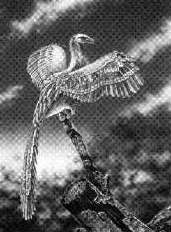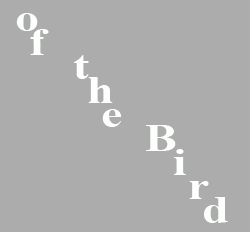|
|
Because of their ability to fly, birds inhabit nearly every part of the Earth - from the oceans and frozen polar zones to steaming rain forests and barren deserts. Their wide-ranging abilities and occupation of diverse habitats have allowed them to diversify into over 9000 species. By comparison, there are only 3000 species of amphibians, 6000 reptiles, and 4600 mammals. The insects, with over 800,000 species, form the most dominant class in the world. Reconstructing the evolution of the Aves is a challenging and ever changing process, as the geological record for the history of birds is brief when compared
with other organisms |
| Many scientists are convinced that birds evolved from the dinosaurs. Numerous finds in recent years have seemed to support the hypothesis that birds descended from two-legged, running dinosaurs called theropods. This theory was born with the discovery of a 150-million-year-old fossilised creature in a swamp in Germany in the 1860s. Archaeopteryx was possibly the most controversial prehistoric remain ever dug up. It is the oldest known bird fossil. Most biologists accept it as conclusive proof that dinosaurs sired birds. |
| But not all scientists agree with the birds-from-dinosaurs link. Alan Feduccia, professor of biology at the University of North Carolina, is a noteable doubter. In 1996 Feduccia investigated an intriguing bird that lived about 135 million years ago, just after Archaeopteryx. The bird,Liaoningornis, did not look like a dinosaur bird at all. It had a breastbone similar to modern birds, with massive flight muscles that enabled longer flights. |
| It was found alongside fossils of ancient birds not unlike Archaeopteryx. Feduccia believes that birds were very widespread by that date, occupying a variety of habitats. He believes most of them died out with the dinosaurs, about 65 million years ago. |
| The ancestors of all today's birds evolved later, he says, between 65 and 53 million years ago, independently of the dinosaurs. This is the "big bang theory" of birds. Feduccia and his fellow sceptics - it must be stressed they are in the minority - regard any similarity between birds and dinosaurs as an example of convergent evolution, by which two independent groups grow to look alike. |
| Since the 1960's and 1970's, however, the evidence from the skeletons has been reexamined, and there is now more evidence supporting common ancestry than convergent evolution. This evidence points to the fact that modern birds and theropod dinosaurs such as Deinonychus (of the Cretaceous period) shared a common ancestor in the Triassic, and that birds living today are in fact highly evolved theropod dinosaurs |
| While scientists continue to debate exactly where birds came from, nobody denies that their subsequent success in colonising the planet has been immense. The power of flight gave birds the edge over most other creatures. They could travel further and wider in search of food, and live where no other creature could go. Millions of years of evolution have adapted each bird species to fit into its own little niche and pre-programmed it to feed, to migrate, to nest and breed in its own particular place and manner. |
|


